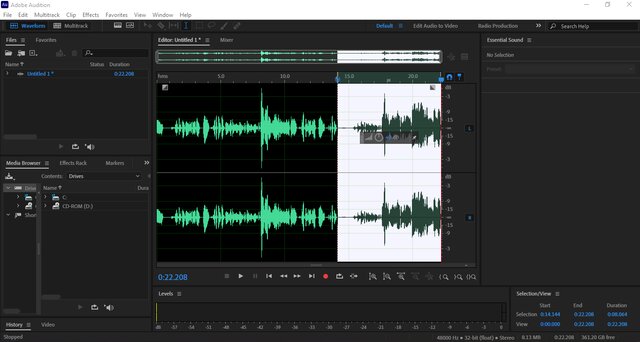

- #Adobe audition podcast workflow movie
- #Adobe audition podcast workflow trial
- #Adobe audition podcast workflow Pc
(For example, when someone accidentally swears, she replaces it with the sound of theĭoctor Who’s sonic screwdriver). “It’s perfect for us, as it features female vocals.” She asked their permission to use it, which they kindly granted. The show does have a theme song (a version of the Doctor Who theme as performed by the English band “It gets the job done, but I think it’s ugly and unintuitive.” (“I like the layout and the easy shortcuts and controls.”) She simply removes the video tracks and works with the audio.
#Adobe audition podcast workflow movie
Sony Movie Studio Platinum to do her podcast editing.
#Adobe audition podcast workflow Pc
It’s not like Macs have a monopoly on podcast editors.Įrika is a PC person and a one-time student of radio, TV, and film production, so she uses a program called Finally, he exports it as a mono spoken podcast to iTunes. Then he adds the enhancements: adding chapters and graphics, applying URLs to chapters, adding a description, and mucking with the metadata that will appear in iTunes. He moves the elements into place, adds opening and closing theme music, and draws in fades (fading the music out as a voice comes in, for example). There, he inserts opening and closing remarks and any ads he might have. For plosives, he uses Audition’s Kill the Mic Rumble preset (in the FFT Filter) “it’s a miracle worker.”Īfter making repairs and cuts where necessary, he exports the results as a mono AIFF track, which he then imports into GarageBand 6. He occasionally fiddles around with a downward expander effect to hide little noises that fall below a certain threshold (“if someone is a lip smacker or heavy breather”). If someone’s too loud, he uses a limiter. He uses Audition’s multiband compressor to give speakers more of an “FM Radio sound” and to punch up their volume. He prefers to adjust the overall volume of a track before applying any effects. He checks the waveform for each track to get an idea of its general loudness. Once he’s gathered together the various tracks, he pulls them into Audition and lines them up so they’re in sync. Scanning overall volume levels in Audition.
#Adobe audition podcast workflow trial
Once his current trial sub expires, he’s going to look for another tool, because “it’s not worth paying Adobe’s Creative Cloud price for this single application.”

The only thing he doesn’t like about Audition: Adobe’s subscription model.

He likes it because “it feels like a real audio editor, something designed for radio and film use.” If he has a problem with something, he has faith that Audition has a solution. Also, he found GarageBand’s audio effects and noise-removal tool too limited, and there’s no built-in way to remove plosives.Īdobe Audition. Among other things, it lacks a ripple-delete function, which automatically moves the audio following a section you’re cutting to the point where you made the cut. But he found editing in that app tedious. But we still thought her overall workflow would be instructive for all podcasters, regardless of their preferred platform.) Christopher BreenĬhris originally did his editing in GarageBand, because he wanted to make enhanced podcasts-AAC files with embedded chapters, links, and images-which GarageBand supports. Macworld Podcast) Editorial Director Jason Snell ( Once again, here’s how four podcasting vets-Christopher Breen (the Depending on the kind of podcast, you may also need to incorporate other audio-music, ambient sound, and other effects. Captured the audio, it’s time to splice it all together and trim it down.


 0 kommentar(er)
0 kommentar(er)
